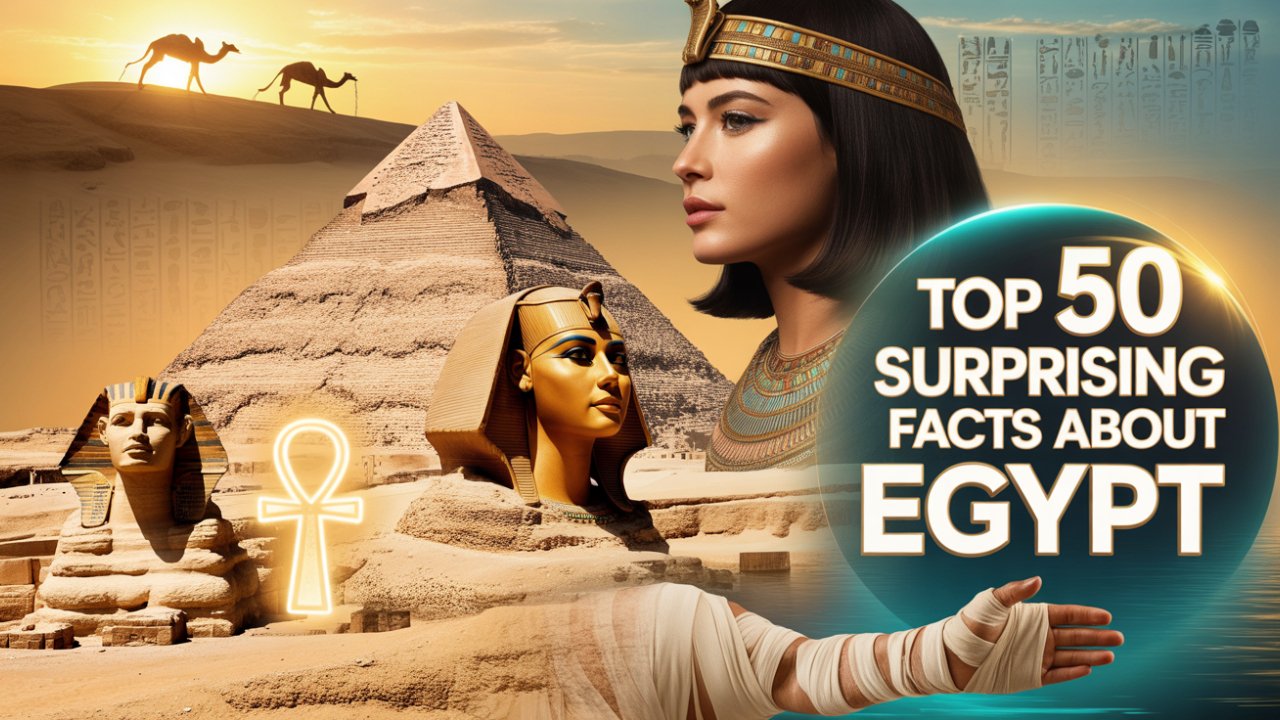What if I told you the Great Pyramids weren’t built by slaves? That Egypt’s most famous queen wasn’t even Egyptian? Or that some mummies were wrapped in bandages that, if unraveled, could stretch for nearly a kilometer?
Forget what you think you know. Everything you assume about this ancient land, from its golden pharaohs to its towering monuments, is about to get turned on its head. We’re about to uncover 50 unbelievable truths that connect Egypt’s legendary past to its shocking present. Get ready to have your mind blown as we separate fact from fiction.
The Pyramids – More Than Just Tombs
Fact #1: The Great Pyramid Was Not Built by Slaves Let’s bust the biggest myth right out of the gate, thanks to decades of Hollywood movies. The Great Pyramid of Giza wasn’t built by slaves. Archaeological discoveries of entire villages built for the workers show that the pyramids were built by tens of thousands of skilled, paid laborers. These were respected craftsmen who were housed, fed, and even given proper burials near the tombs they built. It was a national project, a stunning feat of engineering pulled off by a proud and organized workforce.
Fact #2: The Pyramids Used to Glisten Like Jewels The sandy, weathered pyramids we see today are a pale imitation of their former glory. Originally, the Great Pyramid was covered in a casing of polished, white Tura limestone. These stones were cut so precisely that they would have reflected the sun’s rays, making the whole structure sparkle like a giant jewel visible from miles away. Most of these brilliant casings were later stripped to build mosques and fortresses in Cairo, but you can still see a few at the pyramid’s base.
Fact #3: The Great Pyramid is an Engineering Marvel of Precision It’s hard to wrap your head around the scale of the Great Pyramid—it’s made of about 2.3 million stone blocks, some weighing as much as an SUV. But the truly mind-boggling part is its precision. The base is an almost perfect square, with the sides equal to within a few centimeters. Even crazier, the whole thing is aligned almost perfectly with the four cardinal points—north, south, east, and west—off by just a tiny fraction of a degree. How they did this without modern tech is still one of history’s greatest mysteries.
Fact #4: The Pyramids Maintain a Constant Internal Temperature Egypt’s desert climate is all about extremes: scorching days and chilly nights. And yet, deep inside the pyramids, the temperature stays remarkably constant. No matter the weather outside, the inner chambers hover around a steady 20 degrees Celsius (68 degrees Fahrenheit). This natural insulation is a side effect of the millions of tons of stone, which created a stable environment that has helped preserve everything inside for thousands of years.
Fact #5: The Oldest Pyramid Isn’t at Giza While Giza’s pyramids get all the fame, they aren’t the oldest. That honor goes to the Step Pyramid of Djoser, over at Saqqara. Built around 2630 BC, it’s more than a century older than the Great Pyramid. Designed by the legendary architect Imhotep, it was the world’s first massive stone building and a huge leap forward in architecture. Instead of a flat-topped tomb, Imhotep stacked six layers of decreasing size, creating the iconic step design that set the blueprint for all pyramids to come.
Fact #6: The Pyramids Contain Unexplored Tunnels Beneath the Giza plateau lies a complex and partially unmapped network of tunnels and chambers. While the main rooms like the King’s and Queen’s Chambers are famous, modern tech like cosmic-ray scanning has revealed hidden voids and corridors inside the Great Pyramid that have never been physically explored. Authorities keep some of these areas under wraps, fueling endless speculation about what other secrets these monuments are still hiding.
Fact #7: The Great Pyramid is the Last Surviving Ancient Wonder Of the famous Seven Wonders of the Ancient World—which included the Hanging Gardens of Babylon and the Colossus of Rhodes—only one is still standing: The Great Pyramid of Giza. Finished around 2560 B.C., it was the tallest man-made structure in the world for an incredible 3,800 years. It’s a powerful testament to the skill of its builders that it has survived earthquakes, wars, and the passage of time while every other wonder has crumbled.
Pharaohs and Queens – The Shocking Truths
Fact #8: Cleopatra Wasn’t Egyptian Let’s get this one out of the way: Cleopatra VII, the last and most famous pharaoh of Egypt, was not ethnically Egyptian. She was Greek. She descended from Ptolemy I Soter, one of Alexander the Great’s generals who took over Egypt in the 4th century BC. While her family ruled Egypt for nearly 300 years, they stuck to their Greek language and culture. Cleopatra, however, was the first in her dynasty to actually learn the Egyptian language, which made her pretty popular with the locals.
Fact #9: Cleopatra Lived Closer to the iPhone Than to the Pyramids To put ancient history in perspective, think about this: The Great Pyramid was finished around 2560 BC. Cleopatra lived from 69 BC to 30 BC. This means Cleopatra lived closer in time to the launch of the first iPhone (2007) than she did to the construction of the Great Pyramid. Even to her, the pyramids were ancient wonders.
Fact #10: Female Pharaohs Ruled Egypt Though the role of pharaoh was traditionally for men, several powerful women took the throne. The most famous was Hatshepsut, who ruled for over 20 successful years in the 15th century BC. To cement her authority in a man’s world, she was often shown in statues wearing men’s clothing, including a king’s kilt and even a fake ceremonial beard. Her reign was a time of peace and prosperity, filled with ambitious building projects that rivaled any male pharaoh’s.
Fact #11: Pharaohs Wore Fake Beards Speaking of fake beards, they were a standard accessory for pharaohs, both male and female. This wasn’t a fashion statement; it was a symbol of divinity. The gods, especially the god of the afterlife, Osiris, were often shown with a long, braided beard. By strapping on a false beard, the pharaoh was visually connecting themselves to the gods and reinforcing their divine right to rule.
Fact #12: King Tut Was a Product of Incest The golden mask of Tutankhamun is a symbol of incredible wealth, but the boy king’s life was riddled with health problems. Modern DNA analysis of his mummy revealed that his parents were brother and sister. This royal incest was common among pharaohs who were trying to keep the royal bloodline “pure.” As a result, Tutankhamun suffered from several genetic disorders, including a clubfoot and bone disease, and likely needed a cane to walk.
Fact #13: One Pharaoh Had Over 100 Children Ramses II, also known as Ramses the Great, was one of Egypt’s most powerful and longest-reigning pharaohs. He ruled for an amazing 66 years and lived well into his 90s. In that time, he was busy—not just building monuments, but also building a family. It’s estimated that Ramses II fathered over 100 children with his many wives. His legacy was so huge that nine later pharaohs took his name to try and capture some of his greatness.
Daily Life and Bizarre Beliefs
Fact #14: Makeup Was Worn by Everyone for Protection In ancient Egypt, makeup wasn’t just for the ladies. Men and women from all social classes wore dramatic eye makeup. They used a black kohl eyeliner and green eyeshadow made from powdered malachite. This wasn’t just for looks. The Egyptians believed the makeup had magical healing powers and offered protection from the gods Horus and Ra. On a practical level, the dark kohl helped cut down on the desert sun’s glare and kept flies away.
Fact #15: They Invented Toothpaste Turns out, dental hygiene was a thing even 5,000 years ago. The Egyptians are credited with creating one of the first known forms of toothpaste. The recipe was a bit different from ours today—ingredients included crushed rock salt, mint, dried iris flowers, and pepper. While it was great for cleaning, their diet of coarse bread filled with sand and grit was terrible for their teeth, so dental problems were widespread.
Fact #16: The World’s First Known Labor Strike Happened in Egypt Workers’ rights aren’t a modern concept. The first recorded labor strike in history happened in the 12th century BC, under Pharaoh Ramses III. The skilled artisans building the royal tombs in the Valley of the Kings, who were paid in grain, had their rations repeatedly delayed. Fed up and hungry, they laid down their tools and marched on the temples, shouting “We are hungry!” The protest, detailed on a papyrus scroll, actually worked—the officials eventually handed over the food.
Fact #17: They Played Board Games for the Afterlife The ancient Egyptians loved their board games, and one of the most popular was a game called Senet. The board had 30 squares, and players moved their pieces based on throws of sticks or knucklebones. But Senet was more than just a game; it was tied to the afterlife. Egyptians believed that a successful game of Senet mirrored the soul’s tough journey through the underworld. Because of this, Senet boards were often buried with the dead to help them navigate the challenges ahead.
Fact #18: Cats Were So Sacred, Killing One Was a Capital Crime The ancient Egyptians’ obsession with cats was next-level. Cats were seen as sacred animals, embodying the energy of goddesses like Bastet. They were praised for protecting homes from snakes, scorpions, and rats. This reverence was so intense that killing a cat, even by accident, was a crime punishable by death. When a family cat died, the household would shave their eyebrows as a sign of mourning and often have the cat mummified.
Fact #19: Mummified Bandages Could Stretch for Nearly a Mile The process of mummification was incredibly detailed. A key part was wrapping the body in hundreds of yards of linen. While not typical, for the most elaborate royal mummifications, the unwrapped bandages could stretch for up to a kilometer, with some estimates suggesting they could even approach a mile in length. This wrapping process, which could take up to 15 days, was meant to protect the body and provide a canvas for magical spells.
Fact #20: Women Had Remarkable Rights In a time when most women in other societies had few, if any, rights, ancient Egyptian women were in a different league. They could own property, run businesses, and inherit land without a man’s permission. They could initiate a divorce and were entitled to a third of the couple’s shared property. While they weren’t politically equal to men, their legal and economic freedoms were truly revolutionary for the ancient world.
Fact #21: Beer Was Used as Payment Before coins existed, Egypt ran on a barter system, and one of the most common forms of payment was beer. It was a staple of the Egyptian diet for everyone, from pyramid builders to pharaohs, and was considered safer to drink than water from the Nile. Workers on huge projects received a daily ration of several liters of beer as their wages. It was so central to life that the hieroglyph for “meal” was a combination of the symbols for bread and beer.
Fact #22: They Signed the World’s First Peace Treaty After decades of brutal war between the Egyptian and Hittite Empires, both superpowers realized the endless fighting was draining their resources. In 1259 BC, Pharaoh Ramses II and the Hittite King Hattusili III signed the Treaty of Kadesh. This is the earliest known peace treaty in history where we have the text from both sides. It promised “peace and brotherhood” forever and even included a mutual defense pact. A replica of the treaty hangs in the United Nations headquarters today.
Modern Egypt – Beyond the Ancient World
Fact #23: Egypt is the Most Populous Arab Nation When we think of Egypt, we often picture vast, empty deserts. But modern Egypt is a bustling, crowded country. It’s the most populous nation in the Arab world and the third most populous in Africa. With a population now over 118 million people, the country is teeming with life. A staggering 95% of this population lives on just 5% of the land, squeezed into the fertile Nile Valley and Delta.
Fact #24: Egypt is an Incredibly Young Country Egypt’s population is overwhelmingly young. Recent estimates suggest that around half of its entire population is under the age of 25. This massive youth demographic creates a dynamic and rapidly changing culture, but it also puts huge pressure on the economy and job market. This youthful energy was a key driver of the 2011 revolution, which was largely organized by young people using social media.
Fact #25: Cairo is Called the “Hollywood of the Middle East” Move over, Bollywood. For decades, Cairo has been the absolute center of the Arabic-speaking film industry. Known as the “Hollywood of the Middle East,” Egypt’s cinema has produced thousands of films beloved across the Arab world. At its peak, the Egyptian film industry was one of the largest in the world, and its classic movies and stars are cultural icons for millions.
Fact #26: The Ancient Egyptian Language Still Exists… Sort Of While Arabic is the official language of Egypt, the final stage of the ancient Egyptian language is still used today. The Coptic language evolved from the Demotic phase of ancient Egyptian and is now used as the liturgical language of the Coptic Orthodox Church. Written using the Greek alphabet with a few extra letters, listening to a Coptic mass is the closest anyone can get to hearing what the language of the pharaohs might have sounded like.
Fact #27: The World’s Largest Camel Market is Near Cairo Just outside Cairo is the Birqash Camel Market, one of the biggest and most chaotic animal markets in Africa. Thousands of camels, mostly brought in from Sudan and Somalia, are traded here every week. The market is a dizzying, dusty spectacle of buyers and sellers haggling over prices in a tradition that feels as ancient as the land itself.
Fact #28: The Aswan High Dam Created a Massive Man-Made Lake In the 1960s, Egypt built the Aswan High Dam, a massive modern engineering project. It was designed to control the Nile’s annual floods, generate electricity, and create more farmland. The construction created Lake Nasser, one of the largest artificial lakes in the world. But this progress came at a cost: the rising waters threatened to swallow priceless ancient monuments, including the famous temples of Abu Simbel.
Fact #29: Ancient Temples Were Physically Moved To save the Abu Simbel temples from the rising waters of Lake Nasser, UNESCO launched one of the most ambitious archaeological rescue operations ever. The entire temple complex was painstakingly cut into massive blocks, some weighing up to 30 tons each. These blocks were then dismantled, moved to higher ground 65 meters up, and meticulously put back together. The project took four years and was a stunning feat of global collaboration.
Fact #30: Egypt Spans Two Continents While we think of Egypt as being in North Africa, a small part of it is actually in Asia. The Sinai Peninsula, the triangular piece of land connecting the two continents, makes Egypt a transcontinental country. This unique geopolitical position has been central to its history for thousands of years. The Suez Canal, which separates the Sinai from the rest of Egypt, is one of the most critical shipping shortcuts on the planet.
Fact #31: The Suez Canal is a Global Economic Lifeline The Suez Canal is more than just a waterway; it’s a vital artery for global trade. This 193-kilometer canal provides the fastest sea route between Europe and Asia, letting ships skip the long journey around Africa. Around 12% of all global trade passes through the canal each year. Recent blockages have shown just how critical this chokepoint is to the world economy.
Fact #32: Cairo’s Traffic is Legendary Cairo is a megacity, and that definitely includes its traffic. With millions of cars, buses, and motorcycles all fighting for space, the city’s streets are in a near-constant state of gridlock. Lanes are merely suggestions, horns are their own language, and crossing the street is an extreme sport. The congestion is so bad it’s estimated to cost the Egyptian economy billions of dollars a year.
Fact #33: The World’s Oldest Dress Was Found in Egypt Egypt’s fashion history goes back farther than you can imagine. The world’s oldest known woven garment, the Tarkhan Dress, was found in a tomb near Cairo. Made of linen, this surprisingly sophisticated V-neck dress has been dated to be over 5,000 years old. Its tailored design shows that ancient Egyptians were masters of textiles even at the dawn of civilization.
Fact #34: Egypt Has a “Whale Valley” In the middle of the Western Desert, far from any ocean, is a UNESCO World Heritage site called Wadi Al-Hitan, or “Whale Valley.” This place is littered with the fossilized remains of hundreds of prehistoric whales. These aren’t just any whales; they’re from an extinct group that shows the crucial evolutionary step of whales transitioning from land mammals to ocean dwellers. Some skeletons even have tiny hind legs—stunning proof of evolution right there in the desert.
Fact #35: Football is a National Obsession While ancient history is its claim to fame, modern Egypt’s true passion is football, or soccer. The sport is followed with a religious-like devotion. The rivalry between Cairo’s two biggest clubs, Al Ahly and Zamalek, is one of the most intense in the world. When the national team—known as “The Pharaohs”—is playing, the entire country comes to a standstill.
Fact #36: Egypt’s National Dish is a Carb-Lover’s Dream The undisputed national dish of Egypt is Koshari. It’s a unique creation made of a layered base of rice, macaroni, and lentils. This carb-heavy foundation is then topped with chickpeas, a tangy tomato-vinegar sauce, and, most importantly, a giant pile of crispy fried onions. It’s cheap, filling, and delicious, sold everywhere from street carts to restaurants.
Unbelievable Discoveries and Enduring Mysteries
Fact #37: The Great Sphinx is Carved from a Single Rock Unlike the pyramids, which were built from millions of blocks, the Great Sphinx is a monolith. This massive statue, with the body of a lion and the head of a human, was carved directly from a single, giant piece of bedrock. At 73 meters long and 20 meters high, it’s one of the largest single-stone statues in the world. Who the face is meant to be is still debated, but many believe it’s the Pharaoh Khafre.
Fact #38: The Pyramids of Giza and the Stars of Orion Here’s a controversial one for you. The Orion Correlation Theory proposes that the layout of the three Giza pyramids was deliberately designed to mirror the three stars in Orion’s Belt. Proponents of this theory argue that the pyramid’s positions and sizes match the stars’ alignment and brightness. However, it’s important to know that this is a fringe theory and is not accepted by most Egyptologists.
Fact #39: The First Prosthetic Limb Was an Egyptian Toe The ancient Egyptians were surprisingly skilled in medicine, and that included prosthetics. What’s believed to be the world’s first functional prosthetic body part was found on a mummy from around 950 BC. It was a prosthetic big toe, made from wood and leather, and designed to help a woman walk. The wear and tear on it show it wasn’t just for looks; it was a practical medical device that she used regularly.
Fact #40: They Mummified Millions of Animals Mummification wasn’t just for humans. Archaeologists have found huge catacombs packed with millions of mummified animals. These weren’t just cherished pets; most were animals bred specifically to be killed, mummified, and sold to pilgrims as offerings to the gods. There were mummified cats for the goddess Bastet, crocodiles for Sobek, and ibises for Thoth. One site alone is estimated to hold up to four million mummified ibises. It was a massive religious industry.
Fact #41: The World’s Oldest Religious Texts are in a Pyramid The inside walls of the Pyramid of Unas are covered in columns of hieroglyphs. These are the Pyramid Texts, the oldest known religious writings in the world. Carved around 2400 BC, they are a collection of spells and hymns meant to protect the dead pharaoh and guide his soul into the afterlife. They give us an incredible window into the core beliefs of ancient Egyptian religion.
Fact #42: Hieroglyphs Weren’t Just a “Picture Language” It’s a common myth that hieroglyphs are just simple pictures where each image represents a word. The system is actually way more complex. Some signs do represent a whole word, but many others represent sounds, just like letters in our alphabet. The script is a sophisticated mix of sound-signs, word-signs, and other special signs used to clarify a word’s meaning.
Fact #43: Many Tombs in the Valley of the Kings Remain Unidentified The Valley of the Kings is the famous burial ground for New Kingdom pharaohs like Tutankhamun. While dozens of tombs have been discovered, many are still anonymous. They were either unfinished, undecorated, or looted so long ago that no clue to their owner remains. Archaeologists believe there are still undiscovered tombs hidden in the valley, and the search for the final resting places of figures like Nefertiti and Cleopatra remains the ultimate prize in Egyptology.
Fact #44: The Grand Egyptian Museum is the World’s Largest Archaeological Museum A new colossal structure overlooks the Giza pyramids. The Grand Egyptian Museum (GEM) is the largest archaeological museum in the world dedicated to a single civilization. It will house over 100,000 artifacts, including, for the first time ever, the entire 5,000-piece treasure collection from King Tut’s tomb. Although its official grand opening has faced several delays, with the full opening now anticipated in late 2025, it is partially open for limited tours and is set to redefine cultural tourism.
Fact #45: There Are More Pyramids in Sudan Than in Egypt This might be the most unbelievable fact on this list. While Egypt is famous for pyramids, it doesn’t have the most. That title goes to its southern neighbor, Sudan. Sudan was home to the Kingdom of Kush, a civilization heavily influenced by Egypt that also built pyramids for their royalty. There are over 200 known pyramids in Sudan—roughly double the number in Egypt. They’re smaller and steeper, but they are a spectacular sight.
Fact #46: The Statue of Liberty Was Originally Intended for Egypt The iconic Statue of Liberty in New York Harbor was first designed for a different spot: the Suez Canal. The French sculptor, Frédéric Auguste Bartholdi, was inspired by the huge statues of ancient Egypt and designed a robed female figure holding a torch called “Egypt Carrying the Light to Asia.” He pitched the idea for the entrance of the Suez Canal, but the Egyptian government turned it down because it was too expensive. Bartholdi later reworked the design and gifted it to the United States.
Fact #47: The Library of Alexandria Might Not Have “Burned” The story of the great Library of Alexandria being destroyed in one massive fire is a powerful tale, but the reality is more complicated. There was no single event that destroyed it. Instead, its decline was a slow, gradual process over centuries. It suffered from budget cuts under Roman rulers, the purging of scholars for political reasons, and damage from several military conflicts, including a fire started by Julius Caesar’s troops. It slowly faded away rather than burning down all at once.
Fact #48: The Riddle of the Sphinx is a Greek Invention The famous “Riddle of the Sphinx”—what goes on four feet in the morning, two at noon, and three in the evening?—has nothing to do with Egypt’s Great Sphinx. The riddle comes from the ancient Greek myth of Oedipus, who meets a sphinx near the city of Thebes in Greece. The Egyptian Sphinx isn’t associated with any riddles in its own mythology. It was seen as a guardian and a symbol of royal power, not a mythological quizmaster.
Fact #49: Curses on Tombs Were Mostly for Show The idea of the “Curse of the Pharaohs” exploded after several people connected to the discovery of King Tut’s tomb died mysteriously. But most tombs didn’t have written curses. The few that did were basically ancient “Keep Out” signs, with threats of divine punishment aimed at scaring off tomb robbers. Scientific studies have found no link between entering a tomb and dying early. The “curse” was more likely a mix of media hype and, possibly, exposure to ancient mold or bacteria inside the sealed tombs.
Fact #50: The Story of Egypt is Still Being Written Maybe the most incredible fact is that the story of Egypt is far from over. New discoveries are still being made every single year. Satellites are finding potential new pyramid sites, radar is revealing hidden structures, and archaeologists are constantly unearthing new tombs and artifacts that change what we know about this ancient civilization. Egypt continues to be a land of endless mystery, proving that its greatest treasures may still be waiting to be found.
If your mind is officially blown and you’re seeing Egypt in a new light, hit that like button and subscribe for more deep dives into the world’s greatest mysteries. We have to ask: which of these facts shocked you the most? Was it the shiny pyramids? Or that Sudan has more of them? Let us know in the comments below!
From pyramids built by paid craftsmen to a modern nation buzzing with youthful energy, Egypt is a land of endless surprises. We’ve journeyed from sacred cats to a chaotic camel market, from fake beards to the Hollywood of the Middle East. The story of Egypt is a living, breathing epic that continues to unfold every day. The next time you see a picture of the pyramids, remember all the unbelievable truths hidden just beneath the surface.
Top 50 Surprising Facts About Egypt You Won’t Believe
What if I told you the Great Pyramids weren’t built by slaves? That Egypt’s most famous queen wasn’t even Egyptian? Or that some mummies were wrapped in bandages that, if unraveled, could stretch for nearly a kilometer?
Forget what you think you know. Everything you assume about this ancient land, from its golden pharaohs to its towering monuments, is about to get turned on its head. We’re about to uncover 50 unbelievable truths that connect Egypt’s legendary past to its shocking present. Get ready to have your mind blown as we separate fact from fiction.





